A 2.5D Electrode System Constructed of Magnetic Sb–SnO2 Particles and a PbO2 Electrode and Its Electrocatalysis Application on Acid Red G Degradation
Abstract
:1. Introduction
2. Materials and Experiment
2.1. Chemicals and Reagents
2.2. Electrode and Magnetic Powder Preparation
2.3. Material Characterizations
2.4. Electrode System Characterizations
2.4.1. Determination of Mass Transfer Coefficient
2.4.2. Cyclic Voltammogram Test
2.4.3. The Determination of •OH
2.5. Electrochemical Oxidation Process
2.6. Toxicity Evaluation of Degradation Result
3. Results and Discussion
3.1. The Comparison of 2D and 2.5D Electrode
3.1.1. Mass Transfer Coefficient
3.1.2. Hydroxyl Radicals
3.1.3. Electrochemically Active Site
3.1.4. Electrocatalytic Capacity Comparison
3.2. Degradation of ARG by Using the 2.5D Electrode System
3.2.1. Effect of Current Density
3.2.2. Effect of Initial Organic Concentration
3.2.3. Effect of Temperature
3.3. The Stability of Fe3O4/Sb–SnO2
4. Conclusions
Author Contributions
Funding
Conflicts of Interest
References
- Sarkka, H.; Bhatnagar, A.; Sillanpaa, M. Recent developments of electro-oxidation in water treatment—A review. J. Electroanal. Chem. 2015, 754, 46–56. [Google Scholar] [CrossRef]
- Hao, X.; Hua, G.; Jiangtao, F.; Dan, W.; Zhengwei, L.; Yu, W.; Wei, Y. Electrochemical Oxidation Combined with Adsorption: A Novel Route for Low Concentration Organic Wastewater Treatment. Int. J. Electrochem. Sci. 2019. [Google Scholar] [CrossRef]
- Chaplin, B.P. Critical review of electrochemical advanced oxidation processes for water treatment applications. Environ. Sci.-Proc. Impacts 2014, 16, 1182–1203. [Google Scholar] [CrossRef] [PubMed]
- Zhang, M.; Shi, Q.; Song, X.; Wang, H.; Bian, Z. Recent electrochemical methods in electrochemical degradation of halogenated organics: A review. Environ. Sci. Pollut. Res. Int. 2019, 26, 10457–10486. [Google Scholar] [CrossRef] [PubMed]
- Radjenovic, J.; Sedlak, D.L. Challenges and Opportunities for Electrochemical Processes as Next-Generation Technologies for the Treatment of Contaminated Water. Environ. Sci. Technol. 2015, 49, 11292–11302. [Google Scholar] [CrossRef]
- Jia, W.; Kai, Z.; Hao, X.; Wei, Y. Electrochemical oxidation of rhodamine B by PbO2/Sb-SnO2/TiO2 nanotube arrays electrode. Chin. J. Catal. 2019, 40, 917–927. [Google Scholar]
- Xiaoliang, L.; Hao, X.; Wei, Y. Fabrication and characterization of a PbO2-TiN composite electrode by co-deposition method. J. Electrochem. Soc. 2016, 163, 592–602. [Google Scholar] [CrossRef]
- Wu, W.; Huang, Z.-H.; Lim, T.-T. Recent development of mixed metal oxide anodes for electrochemical oxidation of organic pollutants in water. Appl. Catal. A Gen. 2014, 480, 58–78. [Google Scholar] [CrossRef]
- Yao, Y.; Ren, B.; Yang, Y.; Huang, C.; Li, M. Preparation and electrochemical treatment application of Ce-PbO2/ZrO2 composite electrode in the degradation of acridine orange by electrochemical advanced oxidation process. J. Hazard. Mater. 2019, 361, 141–151. [Google Scholar] [CrossRef]
- Liu, S.; Cui, T.; Xu, A.; Han, W.; Li, J.; Sun, X.; Shen, J.; Wang, L. Electrochemical treatment of flutriafol wastewater using a novel 3D macroporous PbO2 filter: Operating parameters, mechanism and toxicity assessment. J. Hazard. Mater. 2018, 358, 187–197. [Google Scholar] [CrossRef]
- Zhou, X.; Liu, S.; Yu, H.; Xu, A.; Li, J.; Sun, X.; Shen, J.; Han, W.; Wang, L. Electrochemical oxidation of pyrrole, pyrazole and tetrazole using a TiO2 nanotubes based SnO2-Sb/3D highly ordered macro-porous PbO2 electrode. J. Electroanal. Chem. 2018, 826, 181–190. [Google Scholar] [CrossRef]
- Duan, P.; Hu, X.; Ji, Z.; Yang, X.; Sun, Z. Enhanced oxidation potential of Ti/SnO2-Cu electrode for electrochemical degradation of low-concentration ceftazidime in aqueous solution: Performance and degradation pathway. Chemosphere 2018, 212, 594–603. [Google Scholar] [CrossRef] [PubMed]
- Zaviska, F.; Drogui, P.; Blais, J.F.; Mercier, G.; d’Auzay, S.D. Electrochemical Oxidation of Chlortetracycline Using Ti/IrO2 and Ti/PbO2 Anode Electrodes: Application of Experimental Design Methodology. J. Environ. Eng. 2013, 139, 810–821. [Google Scholar] [CrossRef]
- Kaur, R.; Kushwaha, J.P.; Singh, N. Amoxicillin electro-catalytic oxidation using Ti/RuO2 anode: Mechanism, oxidation products and degradation pathway. Electrochim. Acta 2019, 296, 856–866. [Google Scholar] [CrossRef]
- Alcocer, S.; Picos, A.; Uribe, A.R.; Perez, T.; Peralta-Hernandez, J.M. Comparative study for degradation of industrial dyes by electrochemical advanced oxidation processes with BDD anode in a laboratory stirred tank reactor. Chemosphere 2018, 205, 682–689. [Google Scholar] [CrossRef]
- Siedlecka, E.M.; Ofiarska, A.; Borzyszkowska, A.F.; Bialk-Bielinska, A.; Stepnowski, P.; Pieczynska, A. Cytostatic drug removal using electrochemical oxidation with BDD electrode: Degradation pathway and toxicity. Water Res. 2018, 144, 235–245. [Google Scholar] [CrossRef]
- He, Y.; Wang, X.; Huang, W.; Chen, R.; Zhang, W.; Li, H.; Lin, H. Hydrophobic networked PbO2 electrode for electrochemical oxidation of paracetamol drug and degradation mechanism kinetics. Chemosphere 2018, 193, 89–99. [Google Scholar] [CrossRef]
- Comninellis, C.; Vercesi, G.P. Characterization of DSA-type oxygen evolving electrodes Choice of a coating. J. Appl. Electrochem. 1991, 21, 335–345. [Google Scholar] [CrossRef]
- Xiaoliang, L.; Hao, X.; Wei, Y. Electrochemical oxidation of aniline by a novel Ti-TixHy-Sb-SnO2 electrode. Chin. J. Catal. 2016, 37, 1860–1870. [Google Scholar]
- Wachter, N.; Aquino, J.M.; Denadai, M.; Barreiro, J.C.; Silva, A.J.; Cass, Q.B.; Rocha-Filho, R.C.; Bocchi, N. Optimization of the electrochemical degradation process of the antibiotic ciprofloxacin using a double-sided beta-PbO2 anode in a flow reactor: Kinetics, identification of oxidation intermediates and toxicity evaluation. Environ. Sci. Pollut. Res. Int. 2019, 26, 4438–4449. [Google Scholar] [CrossRef]
- Pieczyńska, A.; Ossowski, T.; Bogdanowicz, R.; Siedlecka, E. Electrochemical degradation of textile dyes in a flow reactor: Effect of operating conditions and dyes chemical structure. Int. J. Environ. Sci. Technol. 2018, 16, 929–942. [Google Scholar] [CrossRef]
- Pacheco-Álvarez, M.O.A.; Picos, A.; Pérez-Segura, T.; Peralta-Hernández, J.M. Proposal for highly efficient electrochemical discoloration and degradation of azo dyes with parallel arrangement electrodes. J. Electroanal. Chem. 2019, 838, 195–203. [Google Scholar] [CrossRef]
- Sun, W.; Sun, Y.; Shah, K.J.; Chiang, P.C.; Zheng, H. Electrocatalytic oxidation of tetracycline by Bi-Sn-Sb/gamma-Al2O3 three-dimensional particle electrode. J. Hazard. Mater. 2019, 370, 24–32. [Google Scholar] [CrossRef] [PubMed]
- Mengelizadeh, N.; Pourzamani, H.; Saloot, M.K.; Hajizadeh, Y.; Parseh, I.; Parastar, S.; Niknam, N. Electrochemical Degradation of Reactive Black 5 Using Three-Dimensional Electrochemical System Based on Multiwalled Carbon Nanotubes. J. Environ. Eng. 2019, 145. [Google Scholar] [CrossRef]
- Alighardashi, A.; Aghta, R.S.; Ebrahimzadeh, H. Improvement of Carbamazepine Degradation by a Three-Dimensional Electrochemical (3-EC) Process. Int. J. Environ. Res. 2018, 12, 451–458. [Google Scholar] [CrossRef]
- Hao, X.; Wei, Y.; Honghui, Y. Surface Analysis of Ti/Sb-SnO2/PbO2 Electrode after Long Time Electrolysis. Rare Met. Mater. Eng. 2015, 44, 2637–2641. [Google Scholar] [CrossRef]
- Shao, D.; Yan, W.; Li, X.; Xu, H. Fe3O4/Sb–SnO2Granules Loaded on Ti/Sb–SnO2Electrode Shell by Magnetic Force: Good Recyclability and High Electro-oxidation Performance. ACS Sustain. Chem. Eng. 2015, 3, 1777–1785. [Google Scholar] [CrossRef]
- Shao, D.; Zhang, X.; Lyu, W.; Zhang, Y.; Tan, G.; Xu, H.; Yan, W. Magnetic Assembled Anode Combining PbO2 and Sb-SnO2 Organically as An Effective and Sustainable Electrocatalyst for Wastewater Treatment with Adjustable Attribution and Construction. ACS Appl. Mater. Interfaces 2018, 10, 44385–44395. [Google Scholar] [CrossRef]
- Yao, Y.; Li, M.; Yang, Y.; Cui, L.; Guo, L. Electrochemical degradation of insecticide hexazinone with Bi-doped PbO2 electrode: Influencing factors, intermediates and degradation mechanism. Chemosphere 2019, 216, 812–822. [Google Scholar] [CrossRef]
- Li, X.; Shao, D.; Xu, H.; Lv, W.; Yan, W. Fabrication of a stable Ti/TiOxHy/Sb−SnO2 anode for aniline degradation in different electrolytes. Chem. Eng. J. 2016, 285, 1–10. [Google Scholar] [CrossRef]
- Shao, D.; Yan, W.; Li, X.L.; Yang, H.H.; Xu, H. A Highly Stable Ti/TiHx/Sb-SnO2 Anode: Preparation, Characterization and Application. Ind. Eng. Chem. Res. 2014, 53, 3898–3907. [Google Scholar] [CrossRef]
- Hao, X.; Wuqi, G.; Jia, W.; Jiangtao, F.; Honghui, Y.; Wei, Y. Preparation and characterization of titanium-based PbO2 electrodes modified by ethylene glycol. Rsc Adv. 2016, 6, 7610–7617. [Google Scholar] [CrossRef]
- Xu, H.; Yuan, Q.S.; Shao, D.; Yang, H.H.; Liang, J.D.; Feng, J.T.; Yan, W. Fabrication and characterization of PbO2 electrode modified with [Fe(CN)(6)](3-) and its application on electrochemical degradation of alkali lignin. J. Hazard. Mater. 2015, 286, 509–516. [Google Scholar] [CrossRef]
- Wilk, J.; Grosicki, S. Experimental study of electrochemical mass transfer in an annular duct with the electrolyte nanofluid. Int. J. Therm. Sci. 2018, 129, 280–289. [Google Scholar] [CrossRef]
- Wilk, J. A review of measurements of the mass transfer in minichannels using the limiting current technique. Exp. Therm. Fluid Sci. 2014, 57, 242–249. [Google Scholar] [CrossRef]
- Dalle, A.A.; Domergue, L.; Fourcade, F.; Assadi, A.A.; Djelal, H.; Lendormi, T.; Soutrel, I.; Taha, S.; Amrane, A. Efficiency of DMSO as hydroxyl radical probe in an Electrochemical Advanced Oxidation Process—Reactive oxygen species monitoring and impact of the current density. Electrochim. Acta 2017, 246, 1–8. [Google Scholar] [CrossRef]
- Tai, C.; Peng, J.-F.; Liu, J.-F.; Jiang, G.-B.; Zou, H. Determination of hydroxyl radicals in advanced oxidation processes with dimethyl sulfoxide trapping and liquid chromatography. Anal. Chim. Acta 2004, 527, 73–80. [Google Scholar] [CrossRef]
- Yingwu, Y.; Ganggang, T.; Yang, Y.; Chunjiao, H.; Baicheng, L.; Lin, G. Electrochemical oxidation of acetamiprid using Yb-doped PbO2 electrodes: Electrode characterization, influencing factors and degradation pathways. Sep. Purif. Technol. 2019, 211, 456–466. [Google Scholar] [CrossRef]
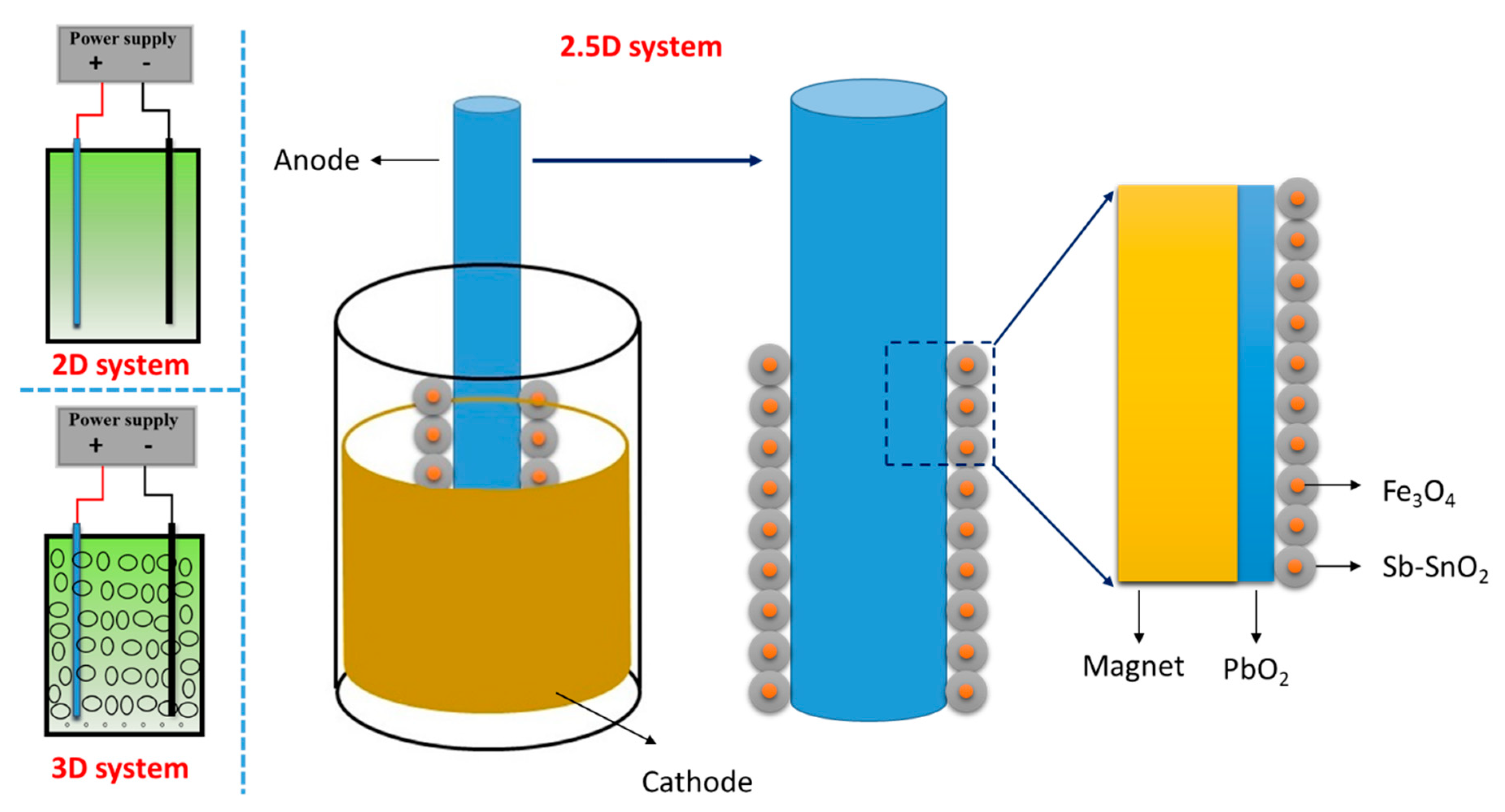
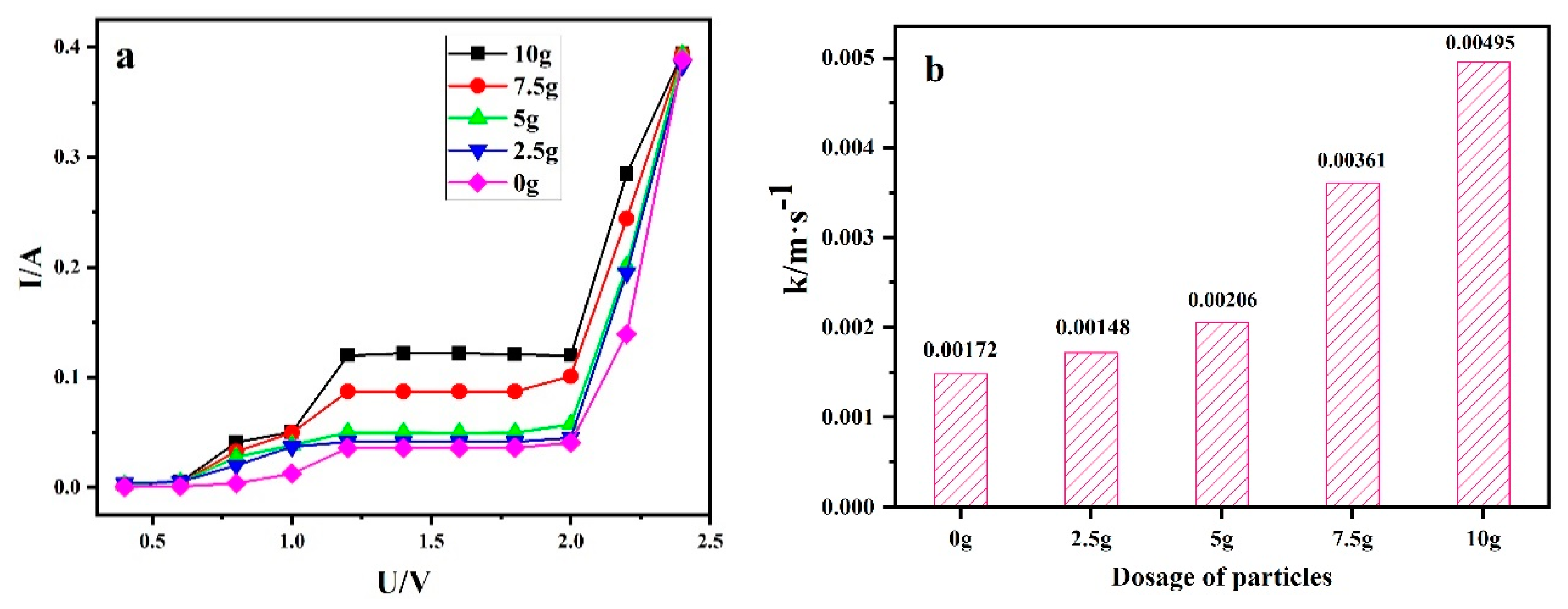
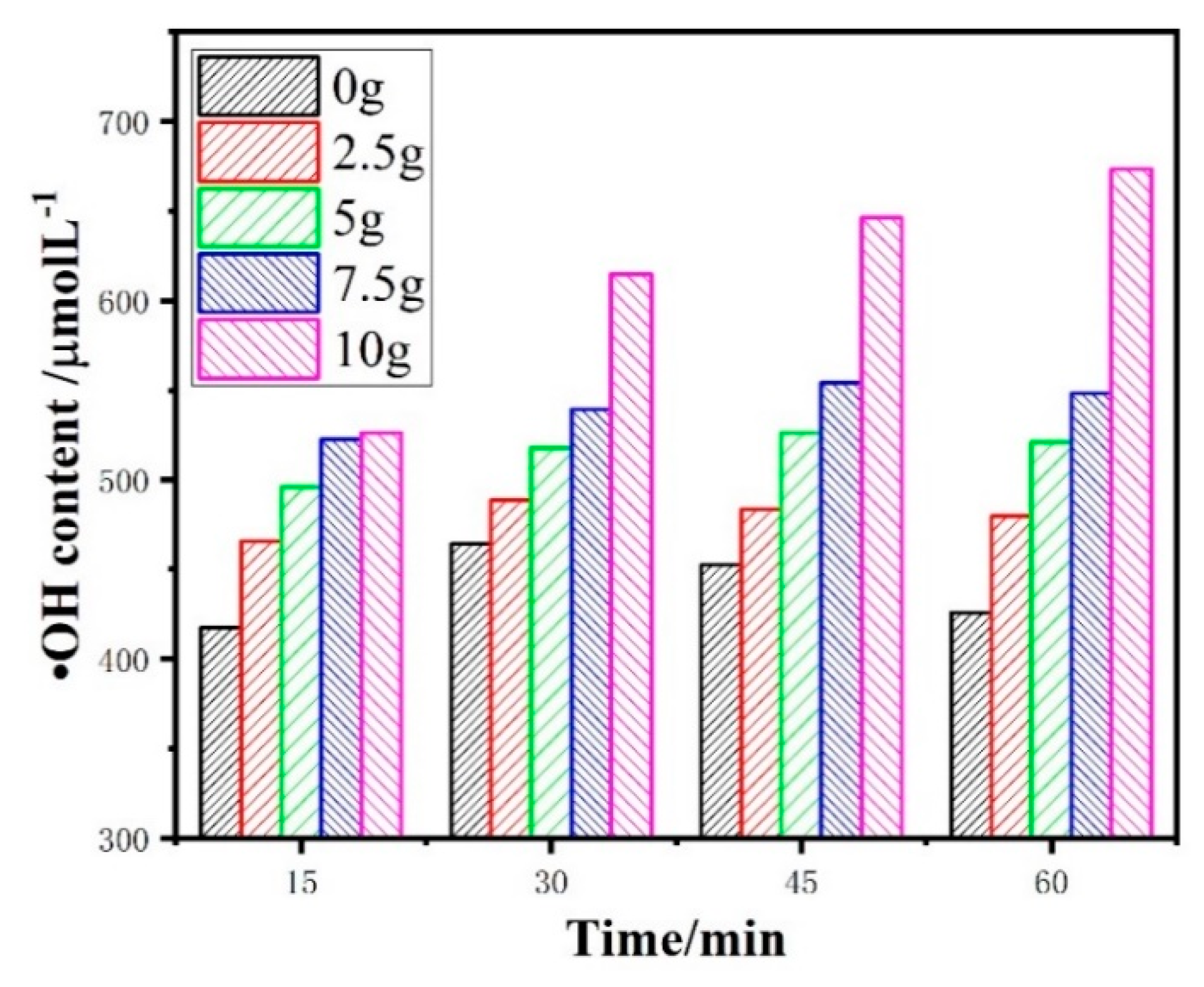
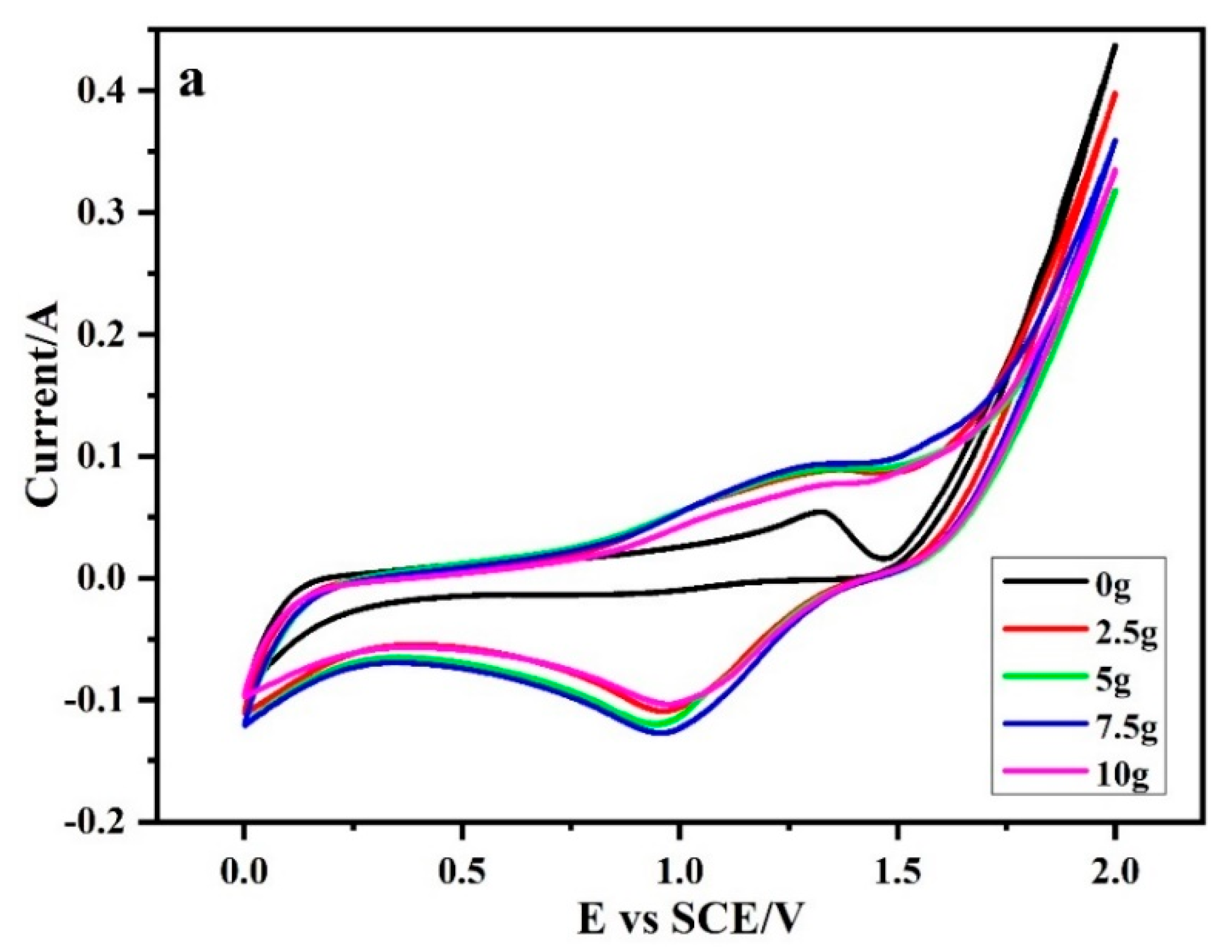

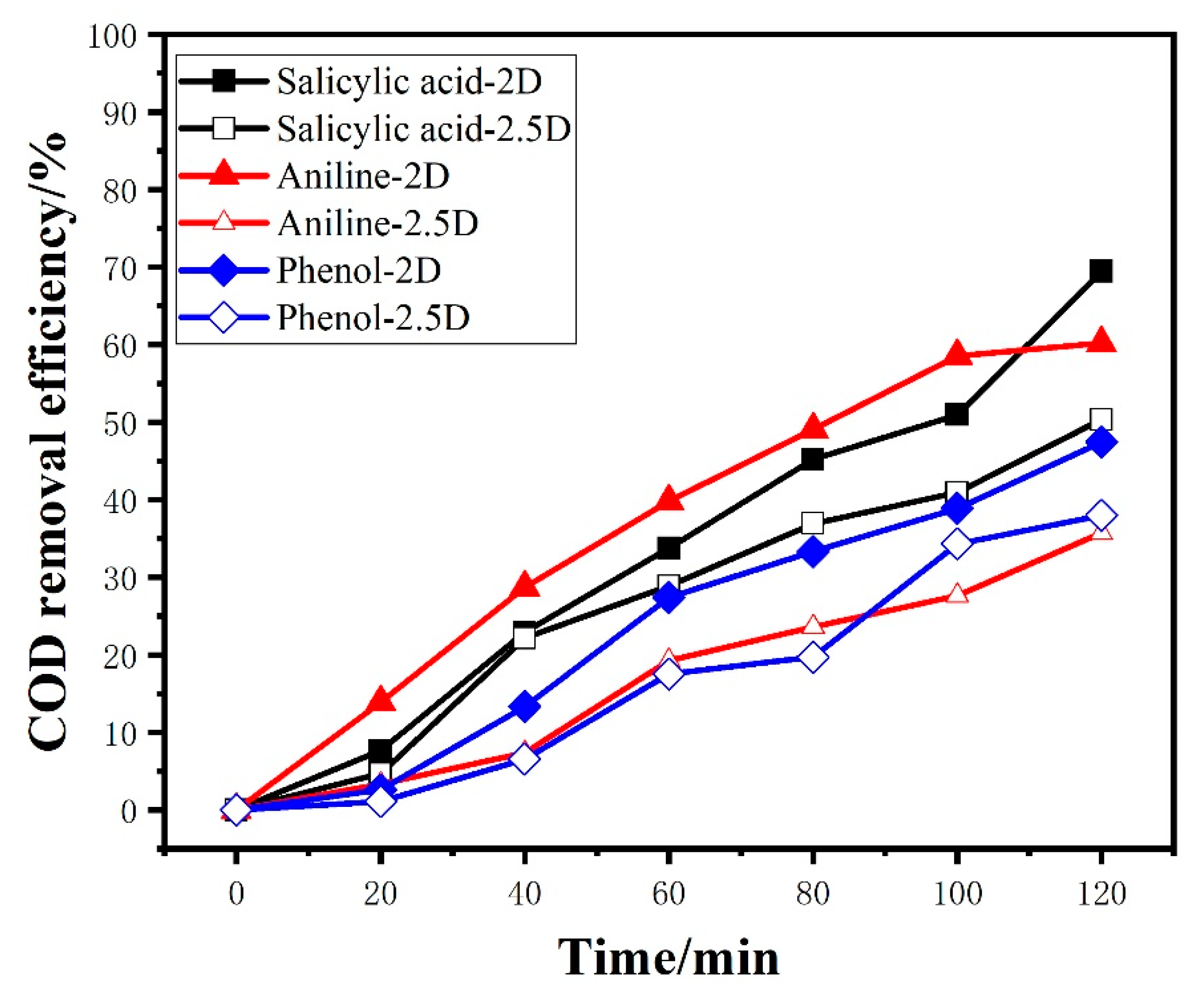
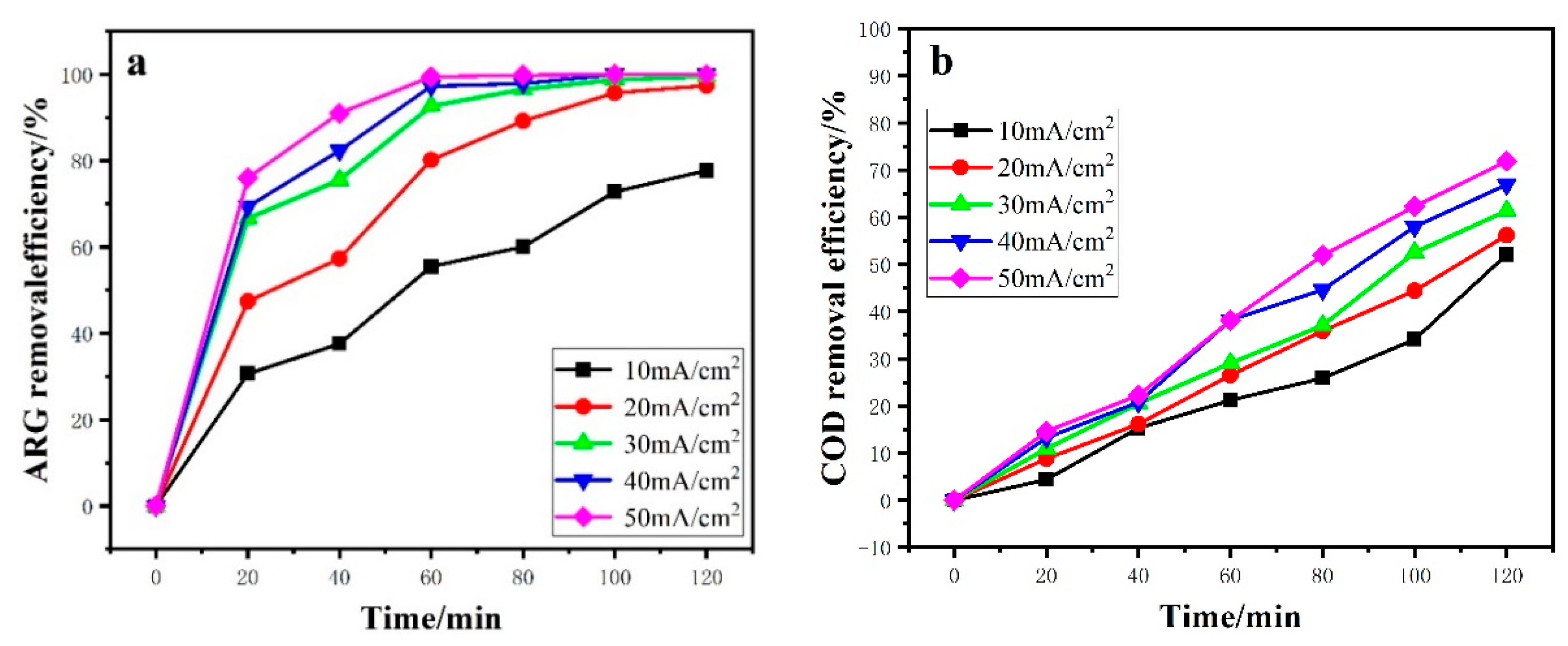
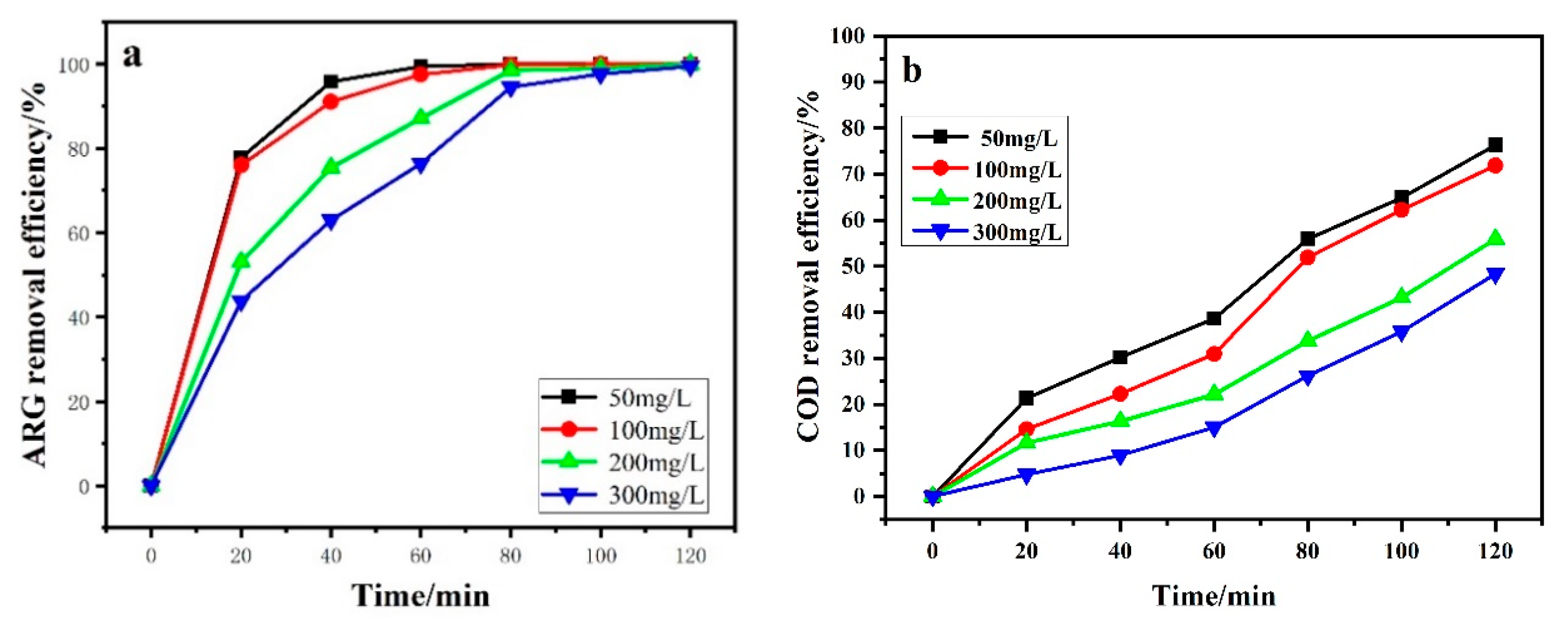
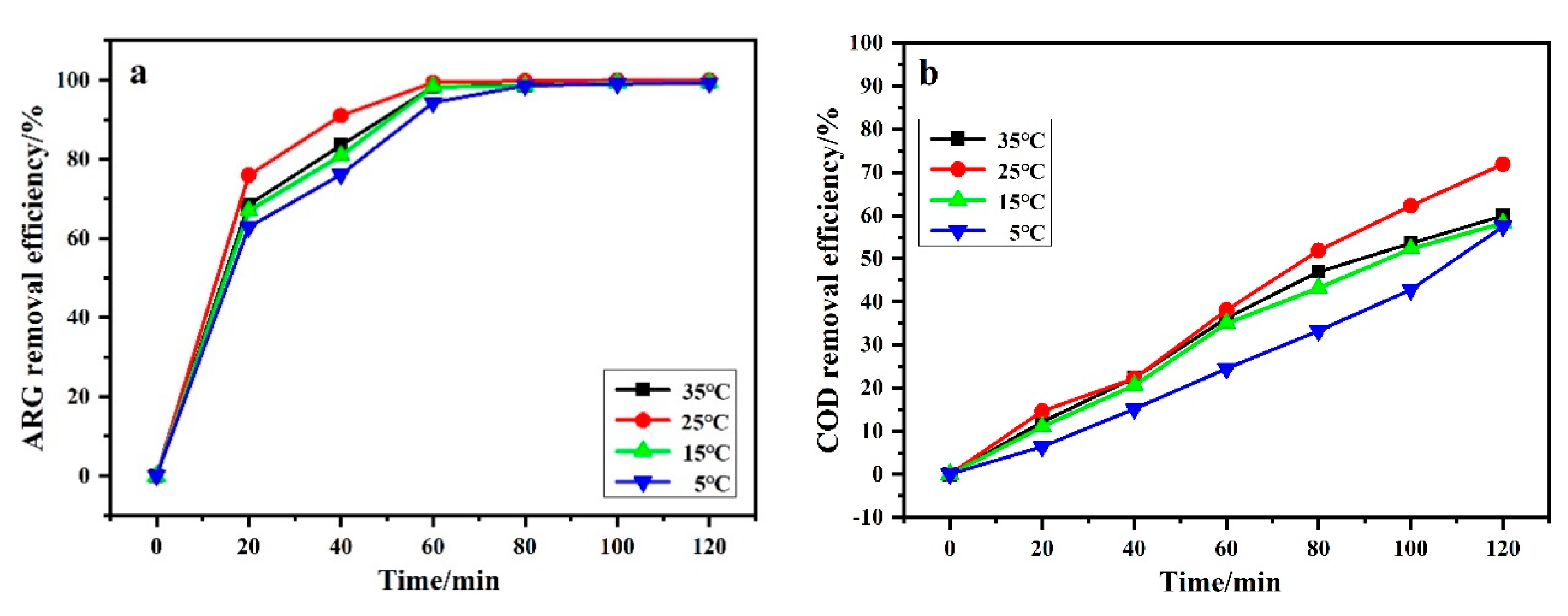
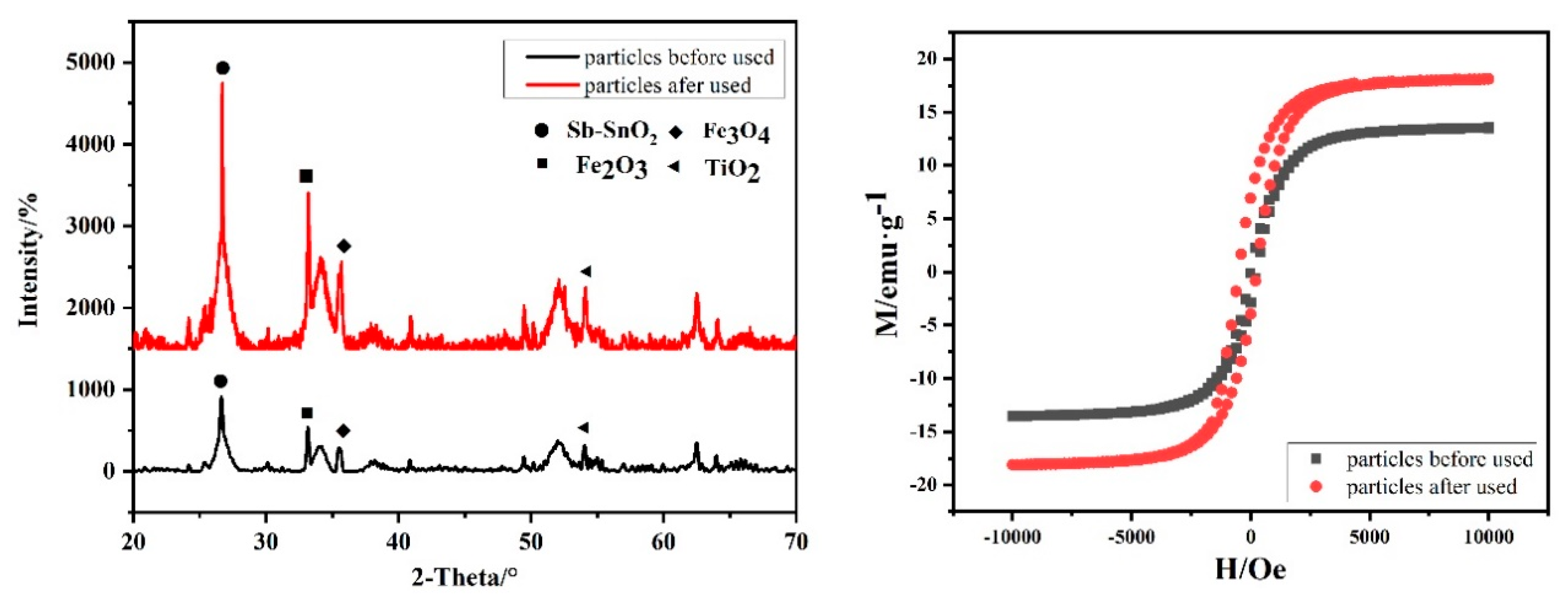
| CE/% | ECCOD/kWh/gCOD | ηTOC/% | ||
|---|---|---|---|---|
| ARG a | 2D | 7.10 | 1.71 | 15.6 |
| 2.5D | 12.2 | 0.961 | 22.6 | |
| Salicylic acid | 2D | 5.04 | 0.45 | 40.85 |
| 2.5D | 7.30 | 0.32 | 54.68 | |
| Phenol | 2D | 6.97 | 0.34 | 27.04 |
| 2.5D | 8.64 | 0.27 | 52.77 | |
| Aniline | 2D | 10.05 | 0.23 | 28.92 |
| 2.5D | 12.06 | 0.19 | 56.01 | |
| CE/% | ECCOD/kWh/gCOD | ηTOC/% | MCE/% | ECTOC/kWh/gTOC | ||
|---|---|---|---|---|---|---|
| Current density (mA/cm2) | 10 | 5.90 | 0.22 | 18.64 | 3.28 | 1.43 |
| 20 | 3.48 | 0.46 | 23.76 | 2.52 | 2.28 | |
| 30 | 2.56 | 0.71 | 27.05 | 1.90 | 3.46 | |
| 40 | 2.45 | 0.83 | 37.35 | 1.97 | 3.74 | |
| 50 | 2.07 | 1.06 | 52.51 | 1.62 | 4.94 | |
| Dye concentration (mg/L) | 50 | 0.89 | 2.43 | 41.77 | 0.86 | 9.13 |
| 100 | 2.07 | 1.06 | 52.52 | 1.62 | 4.94 | |
| 200 | 3.08 | 0.7 | 35.22 | 2.55 | 3.09 | |
| 300 | 3.39 | 0.66 | 17.70 | 1.45 | 5.60 | |
| Temperature (°C) | 5 | 5.76 | 1.72 | 40.69 | 6.8 | 4.60 |
| 15 | 6.48 | 1.46 | 46.07 | 7.92 | 4.03 | |
| 25 | 8.29 | 1.06 | 52.52 | 9.01 | 3.81 | |
| 35 | 5.79 | 1.45 | 62.97 | 11.11 | 3.24 | |
| Sn | Sb | Fe | Ti | C | O | |
|---|---|---|---|---|---|---|
| Before electrolysis | 23.57 | 3.03 | 7.23 | 11.89 | 10.26 | 44.01 |
| After 50 h electrolysis | 20.47 | 2.86 | 11.24 | 12.67 | 10.38 | 42.38 |
© 2019 by the authors. Licensee MDPI, Basel, Switzerland. This article is an open access article distributed under the terms and conditions of the Creative Commons Attribution (CC BY) license (http://creativecommons.org/licenses/by/4.0/).
Share and Cite
Yuan, M.; Salman, N.M.; Guo, H.; Xu, Z.; Xu, H.; Yan, W.; Liao, Z.; Wang, Y. A 2.5D Electrode System Constructed of Magnetic Sb–SnO2 Particles and a PbO2 Electrode and Its Electrocatalysis Application on Acid Red G Degradation. Catalysts 2019, 9, 875. https://doi.org/10.3390/catal9110875
Yuan M, Salman NM, Guo H, Xu Z, Xu H, Yan W, Liao Z, Wang Y. A 2.5D Electrode System Constructed of Magnetic Sb–SnO2 Particles and a PbO2 Electrode and Its Electrocatalysis Application on Acid Red G Degradation. Catalysts. 2019; 9(11):875. https://doi.org/10.3390/catal9110875
Chicago/Turabian StyleYuan, Mengmeng, Nasir Muhammad Salman, Hua Guo, Zhicheng Xu, Hao Xu, Wei Yan, Zhengwei Liao, and Yu Wang. 2019. "A 2.5D Electrode System Constructed of Magnetic Sb–SnO2 Particles and a PbO2 Electrode and Its Electrocatalysis Application on Acid Red G Degradation" Catalysts 9, no. 11: 875. https://doi.org/10.3390/catal9110875
APA StyleYuan, M., Salman, N. M., Guo, H., Xu, Z., Xu, H., Yan, W., Liao, Z., & Wang, Y. (2019). A 2.5D Electrode System Constructed of Magnetic Sb–SnO2 Particles and a PbO2 Electrode and Its Electrocatalysis Application on Acid Red G Degradation. Catalysts, 9(11), 875. https://doi.org/10.3390/catal9110875







